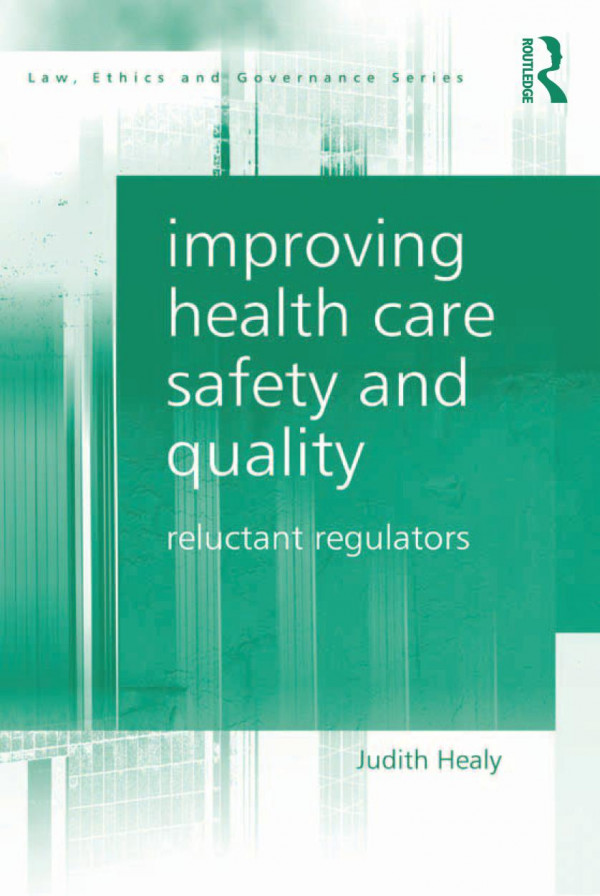(EBOOK PDF)Improving Health Care Safety and Quality Reluctant Regulators 1st Edition by Judith Healy 9781317118206 1317118200 full chapters
$50.00 Original price was: $50.00.$35.00Current price is: $35.00.
Improving Health Care Safety and Quality Reluctant Regulators 1st Edition by Judith Healy – Ebook PDF Instant Download/Delivery: 9781317118206, 1317118200
Full download Improving Health Care Safety and Quality Reluctant Regulators 1st Edition after payment
Product details:
• ISBN 10:1317118200
• ISBN 13:9781317118206
• Author:Judith Healy
Improving Health Care Safety and Quality
Reluctant Regulators
Responding to the public concern caused by recent hospital scandals and accounts of unintended harm to patients, this author draws on her experience of analysing the health care systems of over a dozen countries and examines whether greater regulation has increased patient safety and health care quality. The book adopts a new approach to mapping developments in health care systems in Europe, North America and Australia and pieces together evidence of which regulatory strategies and mechanisms work well to ensure safer patient care. It identifies the regulatory bodies, the regulatory principles and the implementation strategies adopted to improve governance in health care systems and suggests a conceptual framework for responsive regulation. The book will be of interest to government actors, health care professionals and medico-legal scholars.
Improving Health Care Safety and Quality Reluctant Regulators 1st Table of contents:
Preface: Why This Book?
Acknowledgements
1 Introduction: Why Regulate?
A Patient Safety Regulatory Revolution
What is Regulation?
Responsive Regulation
Governance in the Information Age
Why Regulate?
The Regulatory Field
What is the Problem being Regulated?
Who and What is Regulated?
Who regulates?
How regulate?
Does Regulation Work?
Some Conclusions on Evidence of Impact
Study Methods in This Book
Guide to This Book
References
2 How Safe Is Health Care?
Patient Safety: Things that go Wrong in Health Care
People Failure or System Failure?
Has Health Care Become Riskier?
Public Inquiries
United Kingdom
Bristol Royal Infirmary
Ledward and others
Harold Shipman
New Zealand
Public Inquiries into Australian Hospitals
Chelmsford Hospital, Sydney, New South Wales
Ward B, Townsville General Hospital, Queensland
Royal Melbourne Hospital, Victoria
King Edward Memorial Hospital, Western Australia
Canberra Hospital, Australian Capital Territory
Campden and Campbelltown Hospitals, New South Wales
Queensland public hospitals
Acute care hospitals in New South Wales
Retrospective Reviews of Patient Medical Records
Other Data Collections
Quality of Health Care Measurements
Empirical Studies on the Costs of Adverse Events
Classifications of Adverse Events
Classifying Causes of Adverse Events
Other Categories
Types of Incidents: Things that go Wrong for Patients
Pressure ulcers
Health care associated infections
Medication errors
Patient falls
Surgical errors
Blood safety
Conclusion
References
3 Regulatory Actors: Who Governs Health Care?
Regulatory Constellations
Networked and Nodal Governance
Decentred Regulation
Attributes of a Formal Regulator
Eras in Safety and Quality Regulation
Supranational Regulatory Actors
Mapping Regulatory Styles
United States
Government
Professions
Civil society
Market
United Kingdom
Government
Professions
Civil Society
Market
Canada
New Zealand
European Union Countries
Health Sector Governance in Australia
Legislative Authority
Financial Authority
Administrative Authority
Professional Authority
Representative Authority
Regulatory Actors in the Australian Health Sector
Intergovernmental Agencies
National Government Bodies
Australian Department of Health and Ageing
Australian Commission on Safety and Quality in Health Care
Other regulatory agencies
State Government Regulatory Actors
State departments of health
State safety and quality councils
Coroners
Health care complaints commissioners
Civil Society
Market
Professions
Conclusion
References
4 Regulating the Health Professions
Rethinking Medical Governance
Patient-Centred Professionalism
Changing the Medical Culture
The Health Care Workforce
Australia: Regulatory Actors in the Health Professions
Registration Boards
National registration and accreditation
Medical Colleges and Councils
Divisions of General Practice
Australian Medical Council
Professional Associations and Unions
Medical Defence Organizations
Regulatory Mechanisms
Registering Health Professionals
Re-registering health professionals
Assessing International Medical Graduates
Complementary and alternative medicine practitioners: partially regulated practice
Cosmetic surgery: unregulated clinical practice
Regulating relationships with the pharmaceutical industry
Developing Health Professionals
Continuing professional development programmes
Peer review
Disciplining Health Professionals
Complaint investigation model
Performance assessment model
Non-disciplinary pathways
Surveillance model
Conclusion
Registering Professionals
Developing Professionals
Disciplining Professionals
References
5 Safety Cultures and Safety Systems
Designing for Fallibility
A Safety Culture
Attributes of a patient safety culture
Changing organizational and professional cultures
Safety Systems
Regulatory Mechanisms
Adopt a Learning Model Strategy
Develop knowledge networks
Issue clinical practice guidelines or directives
Issue medical alerts
Conduct Clinical Research Collaboratives
Mount patient safety campaigns
Design Safer Systems
Redesign environments and equipment
Roll out information technology
Standardize procedures
Patient identification
Standard inpatient medication chart
Safe patient handover
Conclusion
Is There Evidence That a Learning Strategy Improves Safety and Quality?
Is There Evidence that a Safety Culture Improves Safety and Quality?
Is There Evidence that Better Systems Design Improves Safety and Quality?
References
6 Regulating Staff: Internal Management
Making the Managers Manage
Hospital Governance
Who Runs Hospitals?
Corporate and Clinical Governance
Regulating the Hospital Environment
Train Clinicians in Leadership
Manage Clinical Risk
Engage in Quality Improvement Techniques
Monitor Patient Safety Attitudes and Practices
Regulating Staff
Establishing a Credentials Procedure
Negotiate and Enforce Performance Agreements
Ensure Safe Staffing
Deploy Staff in Multidisciplinary Teams
Regulating Procedures
Embed Clinical Audit
Monitor Performance Indicators
Report Adverse Events in Hospitals
Conduct Critical Incident Analysis
Whistle-blowers: A Failure of Management
Conclusion
Better Quality Management
Better Staff Working Conditions
Better Patient Management
References
7 Regulating Organizations: External Reviews
Reviewing and Inspecting
Types of External Review Schemes
Licensure
Certification
Accreditation
Quality Award Schemes
External peer audit schemes
Reviews using performance indicators
Investigative reviews
Setting Standards
Accreditation Schemes around the World
Hospital Accreditation in Selected Countries
Voluntary Hospital Accreditation Scheme
United States
Voluntary accreditation in other countries
Mandatory Hospital Certification/Accreditation Schemes
England
Other countries
Accreditation in Australia
The Accreditation Field
Accreditation of hospitals
Accreditation of general practices
Accreditation of aged care homes
Regulatory Mechanisms
Regulatory Sanctions
Inspect
Expand standards
Publish reports
Issue warning letter
Conditionally accredit
Investigate
Supervise performance
Impose a penalty
Revoke accreditation/licence
Prosecute
Regulatory Supports
Educative conversations
Relax regulatory regime
Publicize success within the industry
Confer public recognition
Conclusion
References
8 Laws, Money, and Monitoring: Regulation by Enforcement
Enforcement Strategies
Regulation through Legal Instruments
Patient Safety Legal Frameworks
Legislation governing professionals
Legislation governing organizations
Legislation governing technology
Legislation protecting people
Coronial Inquiries
Patient Complaints
Litigation by Patients
Legislation Protecting Professionals
Medical negligence laws
‘Qualified privilege’ for health professionals
Legislation Protecting Patients
Patient rights to medical information
Informed consent by patients
Open Disclosure
Regulation through Financial Mechanisms
Funding Agreements
Regulation through Market Competition
Pay-for-Performance
Regulation through Monitoring
Registers and Databases
Adverse Event Reporting Systems
Sentinel events
Near misses
Measuring and Monitoring Health Care Performance
Public Reporting on Performance as a Regulatory Strategy
Public reporting in several countries
Medicare Payments: Monitoring Fraud and Over-Servicing
Peer review of ‘inappropriate practice’
Conclusion
Do Legal Strategies Improve Safety and Quality?
Consumer complaints to health ombudsmen
Litigation by patients
Patients rights mechanisms
Do Financial Strategies Improve Safety and Quality?
Does Performance Monitoring Improve Safety and Quality?
Peer audit of databases
Adverse event reporting systems
Does public reporting improve performance?
References
9 Regulation by Patients
Concepts of Patients
Regulatory Mechanisms
Informed Patients
Selective Consumers
What people want from doctors and health services
Exercising choice
What information can the public find out about doctors and hospitals?
Vocal Complainants
Express an opinion
Making a complaint
Entitled Citizens
What standard of service can patients expect?
Active Partners
Encouraging patients to speak up
Conclusion
Can Patients Improve Safety And Quality?
References
10 Responsive Regulation: Trust and Transparency
Pressures for Greater Accountability
Principles in Regulatory Design
Trust
Is less, not more, trust in health providers a better regulatory principle?
Transparency
Regulation by revelation
Reluctant Regulators
References
Index
People also search for Improving Health Care Safety and Quality Reluctant Regulators 1st:
improving health care safety
improving healthcare safety includes the following key ideas
improving safety and quality of care in mental health nursing
improving healthcare quality and safety
how to improve safety in healthcare
Tags:
Improving Health,Care Safety,Reluctant Regulators,Judith Healy




